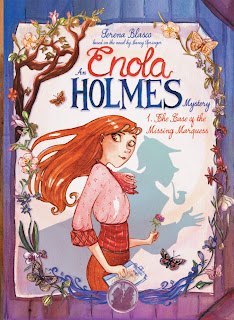In the early 2000s, I picked up a new mystery series for young readers about Enola Holmes - the younger sister of Sherlock Holmes. Written by Nancy Springer, this six-book series followed the adventures of young Enola (whose name spelled backwards is "alone," a play on the fact that Enola spends most of the series alone, on her own, trying to find her missing mother). The series was exceptionally written, with each mystery involving a missing person that Enola must find - all the while, working overtime to avoid discovery by her two overprotective brothers, Sherlock and Mycroft, who want to send her away to a finishing school to become a "proper" young lady.
Once the series ended, I never really gave it more than a passing thought now and then - but recently, IDW comics solicited hardcover graphic novel adaptations of the books. Remembering with fondness the stories I read, I decided to buy them. Turns out, they are not just adaptations, but they are actually translations as well, since the graphic novels originated in France by writer/artist Serena Blasco. The art not your typical comic line-art drawings, but rather, what appears to be water-colored paintings, which each panel/page beautifully rendered, with vibrant colors that jump right off the page. The story flows beautifully from one panel to the next, and from one page to the next - however, as can be expected when you take a full length novel and condense it into a graphic novel with only 56 pages of story and art, it has to be fast-paced, and some elements have to be left out.
The Case of the Missing Marquess, the first book in the series, opens with young Enola getting ready to celebrate her fourteenth birthday - the only problem is, her mother never returns from roaming the countryside, where she goes every day to paint. No explanation, no reason - she simply never returns home, leaving a poor, young Enola truly alone (well, she does have the butler and cook there, but, really, what can they expected to do for a fourteen-year old girl?). After an unfruitful search, she does the only thing she knows to do - she notifies her brothers, Sherlock and Mycroft. Only, instead of locating her mother, they decide the best thing to do is to ship their young sister off to a finishing school. Well, Enola is not having that!
Springer (and Blasco) bring to life a vibrant, young, budding detective who discovers clues that her mother left behind - clues that lead her to quite a bit of money and the logical conclusion that Enola should not have to live and conform to other's expectations - she should be able to live the life of her choosing. And that she does! She carefully plots and before she can be sent away, she runs away and heads for London. The idea of living right there under her own brother's nose, yet in full disguise so as to not be recognized, is absolutely perfect.
Until she stumbles across a mystery. A young marquess has gone missing, and his mother is going frantic with worry. A so-called psychic believes she can located the young boy, but very quickly, Enola realizes what has happened and informs the local constabulary of where they can find the boy. And she's right - except, when they get there, the boy is gone. And so is Enola! They have both fallen captive to a nefarious, money-hungry criminal who sees the two captives as a means to an easy fortune. But they don't know Enola!
Yes, there are some definite elements omitted from the graphic novel that play out in the book - particularly with regards to Enola's search for her mother and the cryptic clues involving flowers and their various meanings. But Blasco manages to capture the charm and essence of Enola Holmes, and the stunning visuals draw the reader into her world with such ease, that even those who are familiar with the books will enjoy the story once again!
One added bonus at the end of the graphic novel is a 6-page excerpt from "Enola's Secret Journal," which provides readers with the various flowers and their meanings, as well as "sketches" that Enola has drawn in her notebook throughout the story - adding further flavor to the book and making it all that more "real" to the reader. I'm hoping each of the graphic novels has excepts like this.
RATING: 8 overly tight corsets out of 10 for reviving this wonderful series in such a great way!

No comments:
Post a Comment